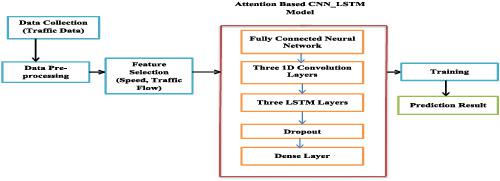当前位置:
X-MOL 学术
›
Int. J. Commun. Syst.
›
论文详情
Our official English website, www.x-mol.net, welcomes your
feedback! (Note: you will need to create a separate account there.)
An attention‐based deep learning model for traffic flow prediction using spatiotemporal features towards sustainable smart city
International Journal of Communication Systems ( IF 1.7 ) Pub Date : 2020-11-11 , DOI: 10.1002/dac.4609 Balachandran Vijayalakshmi 1 , Kadarkarayandi Ramar 2 , NZ. Jhanjhi 3 , Sahil Verma 4 , Madasamy Kaliappan 1 , Kandasamy Vijayalakshmi 1 , Shanmuganathan Vimal 5 , Kavita 4 , Uttam Ghosh 6
International Journal of Communication Systems ( IF 1.7 ) Pub Date : 2020-11-11 , DOI: 10.1002/dac.4609 Balachandran Vijayalakshmi 1 , Kadarkarayandi Ramar 2 , NZ. Jhanjhi 3 , Sahil Verma 4 , Madasamy Kaliappan 1 , Kandasamy Vijayalakshmi 1 , Shanmuganathan Vimal 5 , Kavita 4 , Uttam Ghosh 6
Affiliation

|
In the development of smart cities, the intelligent transportation system (ITS) plays a major role. The dynamic and chaotic nature of the traffic information makes the accurate forecasting of traffic flow as a challengeable one in ITS. The volume of traffic data increases dramatically. We enter the epoch of big data. Hence, a 1deep architecture is necessary to process, analyze, and inference such a large volume of data. To develop a better traffic flow forecasting model, we proposed an attention‐based convolution neural network long short‐term memory (CNN‐LSTM), a multistep prediction model. The proposed scheme uses the spatial and time‐based details of the traffic data, which are extracted using CNN and LSTM networks to improve the model accuracy. The attention‐based model helps to identify the near term traffic details such as speed that is very important for predicting the future value of flow. The results show that our attention‐based CNN‐LSTM prediction model provides better accuracy in terms of prediction during weekdays and weekend days in the case of peak and nonpeak hours also. We used data from the largest traffic data set the California Department of Transportation (Caltrans) for our prediction work.
中文翻译:

基于时空特征的可持续智能城市交通流量预测的基于注意力的深度学习模型
在智慧城市的发展中,智能交通系统(ITS)发挥着重要作用。交通信息的动态性和混乱性使交通流量的准确预测成为ITS中一项具有挑战性的挑战。交通数据量急剧增加。我们进入了大数据时代。因此,必须使用1deep架构来处理,分析和推断如此大量的数据。为了建立更好的交通流量预测模型,我们提出了一种基于注意力的卷积神经网络长短期记忆(CNN-LSTM)多步预测模型。所提出的方案使用交通数据的基于空间和时间的细节,这些细节是使用CNN和LSTM网络提取的,以提高模型的准确性。基于注意力的模型有助于识别近期流量明细,例如速度,这对于预测流量的未来价值非常重要。结果表明,我们的基于注意力的CNN-LSTM预测模型在工作日和周末的高峰和非高峰时段也提供了更好的预测准确性。我们使用来自加利福尼亚交通部(Caltrans)的最大交通数据集的数据进行预测。
更新日期:2021-01-04
中文翻译:

基于时空特征的可持续智能城市交通流量预测的基于注意力的深度学习模型
在智慧城市的发展中,智能交通系统(ITS)发挥着重要作用。交通信息的动态性和混乱性使交通流量的准确预测成为ITS中一项具有挑战性的挑战。交通数据量急剧增加。我们进入了大数据时代。因此,必须使用1deep架构来处理,分析和推断如此大量的数据。为了建立更好的交通流量预测模型,我们提出了一种基于注意力的卷积神经网络长短期记忆(CNN-LSTM)多步预测模型。所提出的方案使用交通数据的基于空间和时间的细节,这些细节是使用CNN和LSTM网络提取的,以提高模型的准确性。基于注意力的模型有助于识别近期流量明细,例如速度,这对于预测流量的未来价值非常重要。结果表明,我们的基于注意力的CNN-LSTM预测模型在工作日和周末的高峰和非高峰时段也提供了更好的预测准确性。我们使用来自加利福尼亚交通部(Caltrans)的最大交通数据集的数据进行预测。











































 京公网安备 11010802027423号
京公网安备 11010802027423号